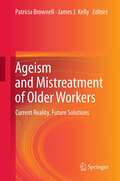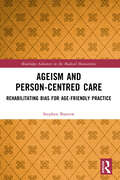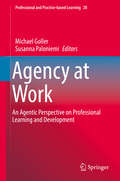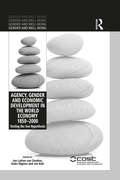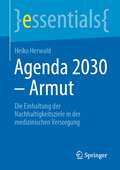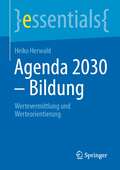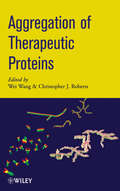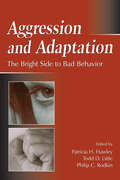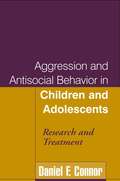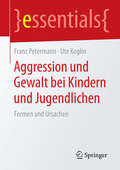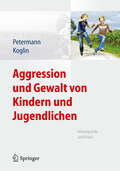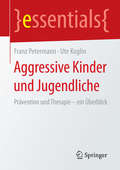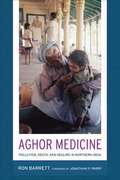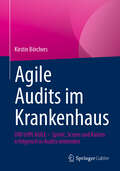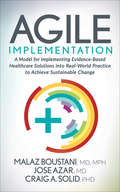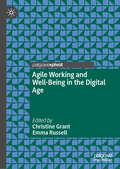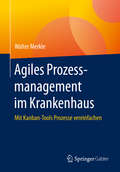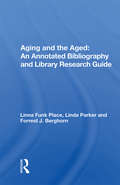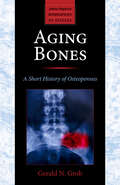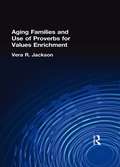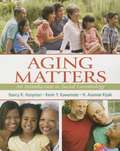- Table View
- List View
Ageism and Mistreatment of Older Workers: Current Reality, Future Solutions
by James J. Kelly Patricia BrownellThis book promotes an understanding of ageism, discrimination and mistreatment of older adult workers, incorporating an international human rights perspective. The impact of ageism on the mistreatment of older adult workers has not to date been examined in depth through the lens of international human rights instruments, nor has discrimination against older adults in the workplace been framed as a form of elder abuse for research and policy making purposes. This book presents a multi-disciplinary exploration of these themes as they affect work and retirement of older adults. It reflects the view that older people who choose to work into old age should be able to do so in enabling work environments that promote dignity and are free of abuse. The contributing authors come from many disciplines, including law, psychology, social work, business, and international affairs. Many are members of the International Network for the Prevention of Elder Abuse (INPEA), a non-governmental organization with consultative status at the United Nations, and have devoted their professional careers to increase awareness and understanding of elder abuse in order to prevent it. The editors hope that broadening the framework within which elder abuse in the workplace is understood will stimulate further research, policy and program development to address this troubling social problem.
Ageism and Person-Centred Care: Rehabilitating Bias for Age-Friendly Practice (Routledge Advances in the Medical Humanities)
by Stephen BuetowThis thought-provoking book exposes the values, judgements, and hierarchies that underlie ageism in care settings. Destabilizing the assumption that biases like ageism are always bad, Buetow suggests that ageism is normatively neutral and that truly person-centred care requires situated acknowledgement of and responsiveness to its negative and positive aspects.Buetow contends that respecting meaningful age differences between persons as moral agents puts ageism on the radar of care environments, weakening barriers to engagement. His analysis moves from concern for age-friendliness to prudent ageism that enables person-centred care to apply practical wisdom in everyday, age-sensitive judgement and decision-making. Challenging political correctness and advocating for justice rather than social justice, Buetow discusses how prudent ageism may advantage some age groups over others in particular circumstances while providing a moral structure for managing real rather than socially constructed differences.Looking at how age-sensitive judgments combined with a person first approach can inform research, policy, and practice, this book will interest students and researchers from fields like health and social care, and disciplines, such as sociology, psychology, politics, and philosophy.
Ageless Nation: The Quest for Superlongevity and Physical Perfection
by Michael G. ZeyIn this intriguing volume, futurist and author Michael G. Zey imagines a time in which technology has stretched human life spans to four hundred years or more. Genetic engineering, cloning, and stem-cell technology will eradicate diseases and allow for nanoscopic repair and maintenance of the body. "Smart drugs" and caloric restriction programs will largely stop aging and ensure healthy bodies and sharp minds indefinitely.Grounding his speculation in contemporary scientific research, Zey's optimistic vision sees retirement replaced by hiatuses between careers, and leisure time spent in multi-generational homes. Key players in the debate include supporters like Cambridge University scientist Aubrey de Grey, who envisions five-thousand-year life spans, and the radical futurist author Ray Kurzweil, who foresees the merging of humans and computers. Organizations such as the Coalition to Extend Life lobby the government for immortality research funding and find opposition in the President's Council on Bioethics and "deep ecologists" advocating zero-population growth.Criticizing current environmental trends as anti-progress and anti-human, Zey's own solutions include controversial measures like human control of weather, colonization of outer space, and genetically modifying food. He concludes that the eventuality of a modern Fountain of Youth is closer than we think. Zey's predictions about the future are thoughtful and fascinating.
Ageless: The New Science of Getting Older Without Getting Old
by Andrew SteeleA startling chronicle by a brilliant young scientist takes us onto the frontiers of the science of aging, and reveals how close we are to an astonishing extension of our life spans and a vastly improved quality of life in our later years.Aging--not cancer, not heart disease--is the true underlying cause of most human death and suffering. We accept as inevitable that as we advance in years our bodies and minds begin to deteriorate and that we are ever more likely to be felled by dementia or disease. But we never really ask--is aging necessary? Biologists, on the other hand, have been investigating that question for years. After all, there are tortoises and salamanders whose risk of dying is the same no matter how old they are. With the help of science, could humans find a way to become old without getting frail, a phenomenon known as "biological immortality"?In Ageless, Andrew Steele, a computational biologist and science writer, takes us on a journey through the laboratories where scientists are studying every bodily system that declines with age--DNA, mitochondria, stem cells, our immune systems--and developing therapies to reverse the trend. With bell-clear writing and intellectual passion, Steele shines a spotlight on a little-known revolution already underway.
Agency at Work: An Agentic Perspective on Professional Learning and Development (Professional and Practice-based Learning #20)
by Michael Goller Susanna PaloniemiMichael Goller gives a structured overview of the current discourses of human agency in relation to professional learning and development. Based on this discussion, the author develops a theoretical framework including human agency as an individual feature (i. e. , a disposition) as well as a set of self-initiated and goal-directed behaviours that are assumed to affect employees' learning and development (e. g. , crafting of new work experiences). He then further specifies this theoretical framework and investigates it empirically in the domain of geriatric care nursing. Based on the findings of the three empirical studies conducted, the author discusses the relevance of human agency for the development of professional expertise of geriatric care nurses.
Agency, Gender and Economic Development in the World Economy 1850–2000: Testing the Sen Hypothesis (Gender and Well-Being)
by Jan Luiten van Zanden Auke Rijpma Jan KokHow has ‘agency’ – or the ability to define and act upon one’s goals – contributed to global long-term economic development during the last 150 years? This book asserts that autonomous decision making, and female agency in particular, increases the potential of a society to generate economic growth and improve its institutions. Inspired by Amartya Sen’s capabilities approach and looking at this in comparison to contemporary economic theory, the collection of chapters tackles the issue of agency from the micro level of household and family formation and asks how this applies to gender at regional and state level. It brings to the fore new empirical data from across the globe to test the links between family systems, female agency, human capital formation, political institutions and economic development and puts these into broader historical context. It will appeal to scholars researching social policy, gender studies, economic history, development studies and philosophy, as well anyone with interests in the long-term societal development of the world economy and issues of global inequality.
Agency, Pregnancy and Persons: Essays in Defense of Human Life (Routledge Annals of Bioethics)
by Nicholas Colgrove Bruce P. Blackshaw Daniel RodgerThis book provides extensive and critical engagement with some of the most recent and compelling arguments favoring abortion choice. It features original essays from leading and emerging philosophers, bioethicists and medical professionals that present philosophically sophisticated and novel arguments against abortion choice. The chapters in this book are divided into three thematic sections. The first set of essays focuses primarily on unborn human individuals—zygotes, embryos and fetuses. In these chapters it is argued, for example, that human organisms begin to exist at conception and that zygotes, embryos and fetuses are persons. These chapters also explore questions about whether or not zygotes, embryos and fetuses are part of their mothers’ bodies. The second set of essays focuses primarily on elective abortion and the debates surrounding it. These chapters consider whether or not opponents of abortion are commonly hypocritical, how opponents of abortion should think about adoption, how emerging technologies may affect the current debate and whether or not those participating in the debate should rely on analogies to support their case. Finally, the third set of essays shifts focus from the legal and moral status of elective abortion to its place in medical practice. In these chapters it is argued that elective abortion embodies a kind of ableism, and that elective abortion is medically unnecessary, harmful to women’s mental health and that telemedicine abortion poses significant risks to women’s health. Agency, Pregnancy and Persons offers an up-to-date examination of unborn human beings, the debates surrounding elective abortion and the place of elective abortion within medical practice. It will be of interest to medical professionals and those who work in philosophy, bioethics and medical ethics alike.
Agenda 2030 – Armut: Die Einhaltung der Nachhaltigkeitsziele in der medizinischen Versorgung (essentials)
by Heiko HerwaldIn diesem essential werden die aktuellen Probleme der Agenda 2030 zur Umsetzung der Nachhaltigkeitsziele im Bereich Gesundheit erläutert. Das weltweite Aufkommen von Zivilisationskrankheiten und die explodierenden Kosten in der medizinischen Versorgung stellen die Weltgemeinschaft in Zeiten von Corona und Krieg vor große Herausforderungen. Um einen weiteren Rückschritt in der globalen Gesundheitsversorgung zu vermeiden, müssen gemeinsame und nachhaltige Lösungen gefunden werden. Hierzu müssen Stakeholder aus allen Sektoren, öffentlichen wie privaten sowie nationalen als auch internationalen, in die Verantwortung genommen werden.
Agenda 2030 – Bildung: Wertevermittlung und Werteorientierung (essentials)
by Heiko HerwaldDie Agenda 2030 hat sich zum Ziel gesetzt, eine Welt ohne Armut, Hunger und Krankheit zu schaffen und dafür zu sorgen, dass jeder Mensch ein Leben frei von Furcht und ohne Unterdrückung führen kann. Um dies zu erreichen, muss jeder Mensch auch ein Recht auf Bildung haben. Ganzheitliche Bildungskonzepte sind hierbei von großer Bedeutung, da mit ihnen ein Umdenken zu einer nachhaltigen Lebensweise in allen Gesellschaftsbereichen erzielt werden kann. Denn ohne eine breite Unterstützung in der Bevölkerung können die Ziele der Agenda 2030 nicht umgesetzt werden. Eine weitere Aufgabe von Bildung ist es, soziale Klassenunterschiede abzubauen. Nach wie vor ist es in vielen Ländern aufgrund von fehlenden Ausbildungsmöglichkeiten nicht möglich, gesellschaftliche Klassenunterschiede zu überwinden. Im vierten der siebzehn Agenda 2030 Nachhaltigkeitsziele spielt das Thema Bildung eine zentrale Rolle. Es wird unter anderen gefordert, flächendeckend Bildungseinrichtungen zu schaffen, damit bis 2030 allen Menschen Zugang zu einer gleichberechtigten und hochwertigen Bildung gewährleistet werden kann.
Aggregation of Therapeutic Proteins
by Wei Wang Christopher J. RobertsThis book gives pharmaceutical scientists an up-to-date resource on protein aggregation and its consequences, and available methods to control or slow down the aggregation process. While significant progress has been made in the past decade, the current understanding of protein aggregation and its consequences is still immature. Prevention or even moderate inhibition of protein aggregation has been mostly experimental. The knowledge in this book can greatly help pharmaceutical scientists in the development of therapeutic proteins, and also instigate further scientific investigations in this area. This book fills such a need by providing an overview on the causes, consequences, characterization, and control of the aggregation of therapeutic proteins.
Aggression and Adaptation: The Bright Side to Bad Behavior
by Todd D. Little Patricia H. Hawley Philip C. RodkinAggression and Adaptation raises thought provoking questions about interpersonal functioning within social groups. The reader may find him/herself entertaining thoughts about the nature of goodness as the chapters suggest that aggressive behavior can offer significant avenues for personal growth, goal attainment, and bolstering one's social st
Aggression and Antisocial Behavior in Children and Adolescents
by Daniel F. ConnorThis comprehensive volume reviews and synthesizes a vast body of knowledge on maladaptive aggression and antisocial behavior in youth. Written from a clinical-developmental perspective, and integrating theory and research from diverse fields, the book examines the origins, development, outcomes, and treatment of this serious problem in contemporary society. Major topics addressed include the types and prevalence of aggressive and antisocial behavior; the interplay among neuropsychiatric, psychosocial, and neurobiological processes in etiology; known risk and protective factors; gender variables; and why and how some children "grow out of" conduct disturbances. Chapters also discuss current approaches to clinical assessment and diagnosis and review the evidence for widely used psychosocial and pharmacological interventions.
Aggression und Gewalt bei Kindern und Jugendlichen: Formen und Ursachen (essentials)
by Franz Petermann Ute KoglinIn diesem Essential werden anhand aktueller Forschungsergebnisse die Formen und Ursachen aggressiv-dissozialen Verhaltens im Kindes- und Jugendalter dargestellt. Aggressiv-dissoziales Verhalten gehört zu den häufigsten Verhaltensproblemen bei Kindern und Jugendlichen. Es wird aufgrund vielfältiger Ziele und Motive eingesetzt. Die Autoren beschreiben den Einfluss von Risiko- und Schutzfaktoren auf die Entstehung und den Verlauf von aggressiv-dissozialem Verhalten.
Aggression und Gewalt von Kindern und Jugendlichen: Hintergründe und Praxis
by Franz Petermann Ute KoglinPsychologische Hilfe: Aggression und Gewalt von Kindern und Jugendlichen Das Thema Aggression und Gewalt verliert nicht an Aktualität, sondern ist aufgrund seiner gesellschaftlichen Relevanz seit Jahrzehnten ein hoch aktuelles Thema. Vor allem das Jugendalter stellt dabei einen besonders sensiblen Entwicklungsabschnitt dar, in dem aggressiv-dissoziales Verhalten ansteigt und extreme Formen annehmen kann. Im öffentlichen Bewusstsein scheinen zunehmend immer jüngere Kinder und Jugendliche sehr schwerwiegendes aggressiv-dissoziales Verhalten zu zeigen. Medien greifen das auf. Psychologen sind gefragt. Neueste empirische Forschungsergebnisse und fundierte Praxis Dieses Buch befasst sich mit den verschiedenen Aspekten, die Psychologen stützend beitragen können: Bedeutung von Risiko- und Schutzfaktoren bei aggressiv-dissozialem Verhalten bei Kindern und Jugendlichen - Erkenntnis und präzise Risikoabschätzung aus aktuellen Studien in den Bereichen Bullying, PC-/Video-Spiele, sexuelle Gewalt bei Jugendlichen und jungen Erwachsenen - Wirksame Programme gegen Aggression und Gewalt, vor allem im Kindes- und Jugendalter - Maßnahmen für junge Kinder und ihre Familien, z.B. soziale Kompetenztrainings - Neue Maßnahmen für Hoch-Risiko-Gruppen im Jugendalter. Ein Buch für alle, die in ihrer Arbeit mit dem Thema Aggression und Gewalt bei Kindern und Jugendlichen konfrontiert sind und fundierte Hintergrundinformationen und Praxishinweise suchen. Geschrieben für Kinder- und Jugendlichenpsychotherapeuten, Schulpsychologen, Mitarbeiter in Beratungsstellen, Kinderärzte, aber auch Studierende der Psychologie, Pädagogik und Medizin (Kinderheilkunde). Gut lesbar, gut strukturiert, mit vielen Fallbeispielen und Praxishinweisen
Aggressive Kinder und Jugendliche: Prävention und Therapie – ein Überblick (essentials)
by Franz Petermann Ute KoglinDas Essential bietet eine aktuelle Übersicht zu Ansatzpunkten für die Prävention aggressiven Verhaltens bei Kindern und Jugendlichen sowie Informationen über wirksame Präventionsangebote und therapeutische Grundprinzipien bei der Behandlung. Die Autoren schildern, wie durch Einbeziehung des sozialen Umfeldes langfristig Erfolge bei der Prävention und Behandlung eines solchen Problemverhaltens erzielt werden können. Neu entwickelte, altersspezifische Therapieansätze (z. B. soziale Kompetenztrainings, Elterntrainings, multisystematische Therapie), die sich als besonders wirksam erwiesen haben, werden vorgestellt. Auf diese Weise können auch aggressive Kinder und Jugendliche zu sozial kompetenten, selbstbewussten Erwachsenen heranwachsen.
Aghor Medicine: Pollution, Death, And Healing In Northern India
by Ron Barrett Jonathan P. Parry Ronald L. BarrettFor centuries, the Aghori have been known as the most radical ascetics in India: living naked on the cremation grounds, meditating on corpses, engaging in cannibalism and coprophagy, and consuming intoxicants out of human skulls. In recent years, however, they have shifted their practices from the embrace of ritually polluted substances to the healing of stigmatized diseases. In the process, they have become a large, socially mainstream, and politically powerful organization. Based on extensive fieldwork, this lucidly written book explores the dynamics of pollution, death, and healing in Aghor medicine. Ron Barrett examines a range of Aghor therapies from ritual bathing to modified Ayurveda and biomedicines and clarifies many misconceptions about this little-studied group and its highly unorthodox, powerful ideas about illness and healing.
Agile Audits im Krankenhaus: DIN trifft AGILE - Sprint, Scrum und Kaizen erfolgreich in Audits einbinden
by Kirstin BörchersAudits im Krankenhaus werden oft noch sehr dokumentenlastig und auf ISO-Konformitätsprüfung ausgerichtet durchgeführt. Dabei geht es in Zeiten von E-Health, Digitalisierung und künstlicher Intelligenz (KI) im Krankenhaus längst um mehr und es ist vor allem eine flexiblere Herangehensweise gefordert. Die aktuellen Transformationsprozesse benötigen schnellere und dynamischere Anpassungen in der Organisation und bei den Abläufen. Mit Hilfe von agilen Audit-Instrumenten wie Scrum, Kaizen und Kanban können diese Herausforderungen gemeistert werden.Dieses Buch stellt nach einer Einführung in die Grundlagen von Audits die wichtigsten agilen Werte, Praktiken und Methoden vor, erläutert ihren möglichen Einsatz im Rahmen des allgemeinen Auditprozesses wie auch in den sogenannten „Audits im Sprint“. Agilität im Qualitätsmanagement und in der Durchführung interner Audits steht nicht im Widerspruch zum Leitfaden ISO 19011 „Auditierung von Managementsystemen“, in dem es um dieWirksamkeit und Eignung des QM-Systems sowie dessen Chancen zur Weiterentwicklung geht – sie ist vielmehr eine konsequente Weiterentwicklung. Best-Practice-Beispiele veranschaulichen, wie eine konkrete Umsetzung im Krankenhausumfeld aussehen kann.
Agile Implementation: A Model for Implementing Evidence-Based Healthcare Solutions into Real-World Practice to Achieve Sustainable Change
by Craig A. Solid Malaz Boustani Jose AzarAgile Implementation describes the underlying theories and frameworks that explain health delivery systems and lays out the 8 steps of the Agile Implementation Model founded by Malaz Boustani, MD, MPH and Jose Azar, MD. In today’s complex healthcare environment, implementing evidence-based care into real-world practices is difficult and time consuming. Even methods that are known to be effective allow for limited flexibility and therefore fail as often as they succeed. Through much study and experimentation, Malaz Boustani, MD, MPH, Jose Azar, MD, and Craig A. Solid, PhD have come to understand how individuals’ interactions within the complex social systems of hospitals, clinics, and other care delivery organizations shape the decisions and behaviors of those involved. Upon this foundation and through leveraging theories of behavioral economics, we have developed the Agile Implementation Model, a process for selecting, adapting, implementing, evaluating, sustaining, and scaling evidence-based healthcare interventions. This model acknowledges the uniqueness of each individual facility and considers individuals within the system to be semiautonomous but interconnected. In tandem with illustrative examples, Agile Implementation describes the underlying theories and frameworks that explain health delivery systems and lays out the 8 steps of the Agile Implementation Model. Upon completing Agile Implementation, readers have a better understanding of why certain quality initiatives succeed while others fail and have tangible, actionable tools for implementing effective and sustainable change in the healthcare setting.
Agile Working and Well-Being in the Digital Age
by Emma Russell Christine GrantWithin the digital era, agile working is imperative for organisations and workers to meet the needs of customers, service-users and ever-changing markets. This needs to be achieved whilst meeting goals of effectiveness and well-being. In this book, state-of-the-art theory is used to understand how to optimise agile working by addressing key issues around personality, team-working and management. The authors define the concept of agile working and unpack often-misunderstood terms associated with this, such as remote working and telework. The book explores the well-being consequences of agile work including sedentary behaviours, digital distraction, and digital resistance before offering insights for the future. Examining current practice in the context of established and emerging theory, the book paves the way towards further advances in the field and supports organisations seeking to make agile working work for them. Agile Working and Well-being in the Digital Age provides a valuable new resource for practitioners and scholars in the fields of occupational and organizational psychology, human resource management, organisational development, mental health and well-being.
Agiles Prozessmanagement im Krankenhaus: Mit Kanban-Tools Prozesse vereinfachen
by Walter MerkleVon anderen lernen – das ist das Erfolgsrezept klugen Managements. Die ursprünglich in und für die Industrie entwickelte Organisationsmethode „Kanban“ beinhaltet allgemeine Organisationsverfahren, die branchenunabhängig nutzbringend eingesetzt werden können. Das gilt auch für einen „klassischen Mittelständler“, wie es ein Krankenhausbetrieb ist.Dieses Buch zeigt, wie sich die vielfältigen und zum Teil gegensätzlichen Erfordernisse in Krankenhäusern bei optimierter Organisation vereinbaren und lösen lassen. Das führt zu einer Verbesserung des Betriebsergebnisses sowie medizinischer Belange, trägt zur Lösung komplexer Diagnostikfälle und zu mehr Personalzufriedenheit und besserer Patientenbehandlung bei. Gleichzeitig gewinnen Kostenträger durch erhöhte Transparenz Vertrauen in die zu finanzierende Situation von Krankenhäusern, um den Versorgungsauftrag nachhaltig erfüllen zu können.
Aging And The Aged: An Annotated Bibliography And Library Research Guide (New Horizons In Marketing Ser.)
by Linna Funk PlaceThis book introduces undergraduates to library research in the field of gerontology and focuses on the wide variety of sources available for research. It covers physiological and psychological aspects of aging; social aspects of aging; and environmental aspects of aging.
Aging Bones: A Short History of Osteoporosis (Johns Hopkins Biographies of Disease)
by Gerald N. GrobHow osteoporosis went from a normal aging process to a disease.In the middle of the twentieth century, few physicians could have predicted that the modern diagnostic category of osteoporosis would emerge to include millions of Americans, predominantly older women. Before World War II, popular attitudes held that the declining physical and mental health of older persons was neither preventable nor reversible and that older people had little to contribute. Moreover, the physiological processes that influenced the health of bones remained mysterious. In Aging Bones, Gerald N. Grob makes a historical inquiry into how this one aspect of aging came to be considered a disease.During the 1950s and 1960s, as more and more people lived to the age of 65, older people emerged as a self-conscious group with distinct interests, and they rejected the pejorative concept of senescence. But they had pressing health needs, and preventing age-related decline became a focus for researchers and clinicians alike.In analyzing how the normal aging of bones was transformed into a medical diagnosis requiring treatment, historian of medicine Grob explores developments in medical science as well as the social, intellectual, economic, demographic, and political changes that transformed American society in the post–World War II decades.Though seemingly straightforward, osteoporosis and its treatment are shaped by illusions about the conquest of disease and aging. These illusions, in turn, are instrumental in shaping our health care system. While bone density tests and osteoporosis treatments are now routinely prescribed, aggressive pharmaceutical intervention has produced results that are inconclusive at best. The fascinating history in Aging Bones will appeal to students and scholars in the history of medicine, health policy, gerontology, endocrinology, and orthopedics, as well as anyone who has been diagnosed with osteoporosis.
Aging Families and Use of Proverbs for Values Enrichment
by Vera R JacksonThose providing services to older persons must develop intervention strategies that are relevant to their clients’life experiences. Aging Families and Use of Proverbs for Values Enrichment presents administrators, practitioners, educators, researchers, and students with intervention models that acknowledge and build upon the proverbs orientation of the older client. This insightful book offers information from contributing authors who have professional and personal experience with the use of proverbs. Proverbs, pithy sayings that underline basic life truths, are shown in this book to work as transmitters of values and as assessment tools.To improve the ability of service programs addressing the needs of older persons, Aging Families and Use of Proverbs for Values Enrichment delineates existing approaches that are low-cost or no cost to the service provider and beneficial to older persons. Moreover, these practices are considered within the context of a conceptual model of proverbs intervention programs for older persons that takes into consideration principles of care, cultural diversity, and family traditions. Contributors examine human competencies, coping mechanisms, and limitations, as well as other more general topics: Rehabilitation: Dispels the myth that older persons can not break long-term habits and learn new things that will improve their lives. Intergenerational Transmission: Discusses family-oriented and cultural values that are passed down from generation to generation via oral tradition. Coping with Life Events: Addresses proverbs as coping mechanisms for surviving the social transitions of life. Health and Health Care: Dispels the myth that some health care practices are taboo among older persons. Cultural and Family Ties: Discusses proverbs as the cornerstone of family sharing regarding life’s lessons. Spirituality: Contrasts African American religiosity with spirituality. Discusses proverbs as messages of faith and hope.Any person who provides services to older persons--social workers, counselors, physicians, nurses, ministers and other members of the clergy, speech and physical therapists, rehabilitation counselors, and family therapists--can benefit from using proverbs, as shown in this book, in their care approach.
Aging Hair
by Ralph M. Trüeb Desmond TobinThe scalp and hair are subject to both intrinsic or physiologic aging and extrinsic or premature aging caused by external factors. This comprehensive and reader-friendly book offers an up-to-date overview on all aspects of hair aging, including in particular the two main streams of interest: the aesthetic problem, which relates to everything that happens outside the skin, and the biologic problem, which concerns the "secret life" of the hair follicle in the depth of the skin. Internationally recognized experts provide detailed contributions on the biologic basis of hair aging and current concepts for its diagnosis, treatment, and prevention. The intrinsic and extrinsic modulating factors for hair growth and pigmentation are explained and future directions for therapeutic intervention are examined. In summary, this unique book offers valuable insights into hair aging and guidance on its treatment; it will prove invaluable both to dermatologists and to other interested physicians and basic scientists.
Aging Matters: An Introduction to Social Gerontology
by Nancy R. Hooyman H. Asuman Kiyak Kevin Y. KawamotoPresents Social Gerontology from Multiple Perspectives Aging Matters illuminates cultural, biological, physiological, emotional, cognitive, economic, and social aspects of aging. A useful guide to a range of disciplines, this title helps readers of all educational backgrounds understand the dynamic interactions between older people and their environments.
